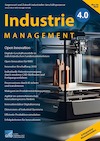Search


Bibtex
Cite as text
@Article{Winkelhaus,
Cite-key = "winkelhaus2021",
Year= "2021",
Number= "3",
Volume= "37",
Pages= "45-48",
Journal = "Industrie 4.0 Management",
Title= "Soziotechnische Systeme: Der Mensch in der Industrie 4.0: Ein Vorgehensmodell zur Analyse",
Author= "Sven {Winkelhaus}",
Doi= "https://doi.org/10.30844/I40M_21-3_S45-48",
Abstract= "Die Einführung neuer Technologien im Zuge von Industrie 4.0 verspricht umfangreiche Effizienz- und Qualitätssteigerungen. Jedoch verändert die Einführung neuer Technologien auch die Arbeitsumgebung für die Beschäftigten. Wird dies vernachlässigt, kann es zu nicht antizipierten negativen Auswirkungen auf das Gesamtsystem kommen. Eine ganzheitliche Sicht auf das soziotechnische System ist notwendig, um diese Effekte bereits bei der Planung zu erkennen und negativen Effekten vorzubeugen. Hierzu wird in diesem Beitrag ein Vorgehensmodell zur Analyse der sich bei der Einführung einer neuen Technologie ergebenen Effekte vorgestellt. Mit der dargestellten Vorgehensweise ist es möglich, strukturiert den Analyseprozess zu durchlaufen und individuell Maßnahmen abzuleiten, um das soziotechnische Gesamtsystem aktiv zu gestalten.",
Keywords= "Soziotechnische Systeme, Vorgehensmodell, Industrie 4.0, Menschliche Faktoren",
}
Sven {Winkelhaus}(2021): Soziotechnische Systeme: Der Mensch in der Industrie 4.0: Ein Vorgehensmodell zur Analyse. 373(2021), S. 45-48. Online: https://doi.org/10.30844/I40M_21-3_S45-48 (Abgerufen 24.12.25)
Open Access
Abstract
Abstract
Die Einführung neuer Technologien im Zuge von Industrie 4.0 verspricht umfangreiche Effizienz- und Qualitätssteigerungen. Jedoch verändert die Einführung neuer Technologien auch die Arbeitsumgebung für die Beschäftigten. Wird dies vernachlässigt, kann es zu nicht antizipierten negativen Auswirkungen auf das Gesamtsystem kommen. Eine ganzheitliche Sicht auf das soziotechnische System ist notwendig, um diese Effekte bereits bei der Planung zu erkennen und negativen Effekten vorzubeugen. Hierzu wird in diesem Beitrag ein Vorgehensmodell zur Analyse der sich bei der Einführung einer neuen Technologie ergebenen Effekte vorgestellt. Mit der dargestellten Vorgehensweise ist es möglich, strukturiert den Analyseprozess zu durchlaufen und individuell Maßnahmen abzuleiten, um das soziotechnische Gesamtsystem aktiv zu gestalten.
Keywords
Schlüsselwörter
Soziotechnische Systeme, Vorgehensmodell, Industrie 4.0, Menschliche Faktoren
References
Referenzen
[1] Lu, Y., Industry 4.0: A survey on technologies, applications and open research issues. In: Journal of Industrial Information Integration 6 (2017), S. 1-10.
[2] Kagermann, H.; Wahlster, W.; Helbig, J.: Recommendations for implementing the strategic initiative Industrie 4.0, Securing the future of German manufacturing industry, Final report of the Industrie 4.0 Working Group. Berlin 2013.
[3] Neumann, W. P. u. a.: Industry 4.0 and the human factor – A systems framework and analysis methodology for successful development. In: International Journal of Production Economics 233 (2021), 107992.
[4] Romero, D. u. a.: Towards an Operator 4.0 Typology: A Human-Centric Perspective on the Fourth Industrial Revolution Technologies. In: Proceedings of the International Conference on Computers and Industrial Engineering. Tianjin, China 2016.
[5] Rohleder, B.: Digitalisierung der Logistik. Berlin 2019.
[6] Brynjolfsson, E.; McAfee, A.: The second machine age: Work, progress, and prosperity in a time of brilliant technologies. New York 2014.
[7] Rose, L. M.; Orrenius, U. E.; Neumann, W. P.: Work environment and the bottom line: Survey of tools relating work environment to business results. In: Human Factors and Ergonomics in Manufacturing & Service Industries 23 (2013) 5, S. 368-381.
[8] Breque, M.; De Nul, L.; Petridis, A.: Industry 5.0 – Towards a sustainable, human-centric and resilient European industry, European Union. Bruxelles 2021.
[9] Neumann, W. P.; Dul, J.: Human Factors: Spanning the Gap between OM & HRM. In: International Journal of Operations & Production Management 30 (2010) 9, S. 923-950.
[10] Shipton, H. J. u. a.: When promoting positive feelings pays: Aggregate job satisfaction, work design features, and innovation in manufacturing organizations. In: European Journal of Work and Organizational Psychology 15 (2006) 4, S. 404-430.
[11] Russell-Walling, E.: Scientific Management, in 50 Schlüsselideen Management. Heidelberg 2011.
[12] Waschull, S. u. a.: Work design in future industrial production: Transforming towards cyber-physical systems. In: Computers & Industrial Engineering 139 (2020), 105679.
[13] Lüdtke, A.: Wege aus der Ironie in Richtung ernsthafter Automatisierung, In: Botthof, A.; Hartmann, E. (Hrsg.): Zukunft der Arbeit in Industrie 4.0. Heidelberg 2015, S. 125-146.
[14] Peissner, M.; Hipp, C.: Potenziale der Mensch-Technik-Interaktion für die effiziente und vernetzte Produktion von morgen. Stuttgart 2013.
[15] Wieland, R.: Digitalisierung und der Mensch. In: Forschungsmagazin der bergischen Universität Wuppertal BUW.OUTPUT 21 (2019), S. 6-11.
[16] Dregger, J. u. a.: Challenges for the future of industrial labor in manufacturing and logistics using the example of order picking systems. In: Procedia CIRP 67 (2018), S. 140-143.
[17] Reiman, A. u.a.: Human factors and ergonomics in manufacturing in the industry 4.0 context – A scoping review. In: Technology in Society, 65 (2021), 101572.
[18] Ulich, E.: Arbeitspsychologie. 7. Auflage, Stuttgart 2011.
[19] Sgarbossa, F. u. a.: Human factors in production and logistics systems of the future. In: Annual Reviews in Control 49 (2020), S. 295-305.
[20] Kadir, B. A.; Broberg, O.; Conceição, C. S. d.: Current research and future perspectives on human factors and ergonomics in Industry 4.0. In: Computers & Industrial Engineering 137 (2019), S. 1-12.

 English
English